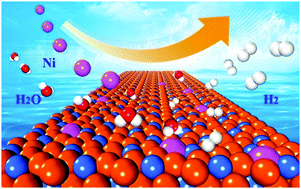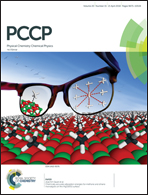Theoretical insights into the effective hydrogen evolution on Cu3P and its evident improvement by surface-doped Ni atoms†
Abstract
On the basis of the first-principles DFT computations, we have systematically investigated the structures and hydrogen evolution reaction (HER) catalytic activities for pristine and Ni-doped Cu3P systems. It was revealed that the (1![[1 with combining macron]](https://www.rsc.org/images/entities/char_0031_0304.gif) 0) surface could be the one with the most exposure for the Cu3P structure. The calculated free energy values of H* (ΔGH*) are in the range from 0.012 to 0.320 eV, reflecting the HER activity on the (1
0) surface could be the one with the most exposure for the Cu3P structure. The calculated free energy values of H* (ΔGH*) are in the range from 0.012 to 0.320 eV, reflecting the HER activity on the (1![[1 with combining macron]](https://www.rsc.org/images/entities/char_0031_0304.gif) 0) surface, which is consistent with the experimentally reported results. Our computed results also reveal that the top sites over P atoms as well as the bridge and hollow sites composed of Cu atoms can make the main contribution to the HER activity on the (1
0) surface, which is consistent with the experimentally reported results. Our computed results also reveal that the top sites over P atoms as well as the bridge and hollow sites composed of Cu atoms can make the main contribution to the HER activity on the (1![[1 with combining macron]](https://www.rsc.org/images/entities/char_0031_0304.gif) 0) surface, and the hollow sites (ΔGH* ≈ 0 eV) can serve as the most active sites due to the considerably flexible structural features. Furthermore, we have proposed an effective strategy through doping Ni to significantly improve the HER catalytic activity on the (1
0) surface, and the hollow sites (ΔGH* ≈ 0 eV) can serve as the most active sites due to the considerably flexible structural features. Furthermore, we have proposed an effective strategy through doping Ni to significantly improve the HER catalytic activity on the (1![[1 with combining macron]](https://www.rsc.org/images/entities/char_0031_0304.gif) 0) surface by effectively optimizing the adsorption state of H* based on the case that Ni and Cu have the opposite ability to bind with H. All these doped systems can uniformly possess high HER activity, and particularly some doped structures with the appropriate Ni-atom number can even exhibit considerably high HER activity over a wide range of H coverage, indicating the more excellent catalytic performance. It is worth mentioning that the surface-metal-atoms for these Ni-doped systems can still exhibit flexible behavior, which can also be beneficial for realizing high HER activity. These fascinating theoretical insights at the atomic level can be advantageous for achieving highly efficient non-precious HER electrocatalysts based on copper phosphide and even other transition metal phosphides in the near future.
0) surface by effectively optimizing the adsorption state of H* based on the case that Ni and Cu have the opposite ability to bind with H. All these doped systems can uniformly possess high HER activity, and particularly some doped structures with the appropriate Ni-atom number can even exhibit considerably high HER activity over a wide range of H coverage, indicating the more excellent catalytic performance. It is worth mentioning that the surface-metal-atoms for these Ni-doped systems can still exhibit flexible behavior, which can also be beneficial for realizing high HER activity. These fascinating theoretical insights at the atomic level can be advantageous for achieving highly efficient non-precious HER electrocatalysts based on copper phosphide and even other transition metal phosphides in the near future.



 Please wait while we load your content...
Please wait while we load your content...